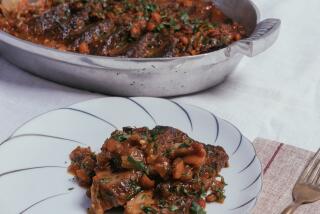Tough Love: A Brisket Recipe : Suffering from tough, fatty brisket? There is a cure.
- Share via
This Hanukkah will be different. I’ve finally gotten the nerve to save my family from disaster. Well, maybe not disaster, but at least indigestion.
I’ve decided to confront my mother with the truth about her brisket. Mom, your brisket is tough. It’s fatty too.
The truth hurts, but so does swallowing dry meat. For years I’ve dreamed of taking over in the kitchen just so that I could make the brisket.
Latkes and brisket are part of every Hanukkah. Every family has its own recipe for latkes, and every family seems to share my mother’s recipe for brisket. The latkes are always to die for, and the brisket is always tough and fatty.
But brisket doesn’t have to be tough and fatty. It can be tender, it can be juicy, it can be wonderful.
Don’t misunderstand. I don’t want to rewrite my family’s holiday script. Tradition is important. I couldn’t imagine Hanukkah without my family, all of their lovable idiosyncrasies, or my mother’s latkes. (Let me emphasize here again that my mother makes wonderful latkes.) And I do want to maintain the holiday brisket tradition. I only want to change the way the brisket is prepared.
Brisket is a tough cut of meat. This does not mean that all hope for a tender, juicy slice of lean brisket is lost. I have found in my years of cooking away from home that understanding the nature of a cut of meat is the key to making it taste good. Knowledge is power.
Brisket contains a lot of connective tissue, which can make it tough. The type of connective tissue in brisket is called collagen. Cook the meat quickly and you get tough, dry meat. Cook a brisket slowly, with some liquid, and the collagen turns into gelatin. A tender and moist brisket is the result.
A second problem with brisket is that it tends to be fatty. The secret to serving a tender and yet lean brisket is cooking it in two stages. First, cook it covered, with broth and seasonings, at a low temperature for a long time. Then cool the meat for several hours or overnight. Refrigerate the cooking liquid separately and remove the fat that rises to the top and hardens. When the meat has cooled, cut off the fatty top layer. Slice the brisket into 1/4-inch-thick slices and put the slices into a roasting pan. Cover the sliced meat with the defatted cooking liquid and reheat slowly. All the fat is gone and the meat is tender and juicy. This is why, I found out, my Mom’s leftover brisket, reheated in its juices, came out tender and tasted so much better than it did the night it was first served. This is why I actually look forward to Mom’s leftover brisket.
I will remind my mother of this as I explain my recipe for perfect brisket. I’ll also remind her that as she cuts the fat off the cold brisket, she should look for the small piece of meat sometimes contained within the fat cap. She can cut the fat off this piece as well. She can slice that bit of meat and heat it with the larger slices or save it for sandwiches the next day.
One great thing about this recipe is that Mom can cook the brisket a day or two ahead and, on the first night of Hanukkah, all she needs to do is remove the fat, slice it and reheat. So in addition to a recipe I’m giving Mom some free time.
Which means she’ll have plenty of time to make latkes.
*
The Perfect Brisket
Active Work Time: 45 minutes * Total Preparation Time: 9 hours, 15 minutes
Note that all of the cooking takes place in the same roasting pan. For smaller briskets, a Dutch oven will work. Use a turkey roaster for larger briskets.
2 tablespoons olive oil
3 onions, cut in half, then into strips
3 cloves garlic, minced
1 pound white mushrooms, sliced
1 cup red wine
2 (10 1/2-ounce) cans double-strength beef broth
1 (6-ounce) can tomato paste
1 cup currant jelly
Salt, pepper
1 (3 1/2- to 4-pound) beef brisket
* Heat olive oil over medium-high heat in Dutch oven or roaster. Add onion strips and cook until translucent, about 5 minutes.
* Add minced garlic and saute 1 minute. Add mushrooms and red wine. Increase heat to high and reduce liquid by cooking, stirring often, until liquid is gone, 10 to 12 minutes.
* While mushrooms and onions cook, whisk together broth, tomato paste and currant jelly in nonreactive mixing bowl. Add to mushrooms and onions when wine reduces. Stir to incorporate and season with salt and pepper to taste. Scrape mushrooms and onions into bowl.
* Sear brisket, fat side down, in same pan used for mushrooms and onions over high heat 2 to 3 minutes, then turn over and sear other side 2 to 3 more minutes.
* Pour sauce over top of brisket. Lift edges of meat so liquid goes underneath.
* Bake brisket, covered, at 300 degrees for 2 hours.
* Remove brisket from oven and let stand, uncovered, at room temperature 1 hour.
* Wrap brisket in foil. Refrigerate at least 4 hours, or up to 2 days. Refrigerate cooking liquid in separate container.
* About 1 1/2 hours before serving dinner, remove meat and cooking liquid from refrigerator.
* Remove congealed fat from top of cooking liquid.
* Using sharp knife, remove entire fatty top side of brisket and all other visible fat.
* Slice meat into 1/4-inch-thick slices (cut meat across the grain for maximum tenderness).
* Place slices in pan and cover with defatted juices. Bake, covered, at 300 degrees 1 to 1 1/2 hours.
* Serve with pan juices.
6 servings. Each serving: 842 calories, 931 mg sodium, 151 mg cholesterol, 63 grams fat, 24 grams carbohydrates, 37 grams protein, 1.09 grams fiber.
More to Read
Eat your way across L.A.
Get our weekly Tasting Notes newsletter for reviews, news and more.
You may occasionally receive promotional content from the Los Angeles Times.










